Griffith University 7010EDN: Leading, Mentoring, Coaching Report
VerifiedAdded on 2022/11/15
|11
|3441
|390
Report
AI Summary
This report provides an in-depth analysis of the GROW model within a learning context, focusing on its application to mentoring and coaching in tutoring services. The report begins by introducing the GROW model (Goal, Reality, Obstacles/Options, and Will) as a framework for decision-making and skill development in academic settings. It then details each component of the model, including goal setting using the SMART approach, assessing the current state, exploring options, and establishing the will to achieve objectives. The report justifies the GROW model theoretically, highlighting its flexibility, promotion of confidence, and applicability across various disciplines. Furthermore, it discusses the model's effectiveness, emphasizing its simplicity, adaptability, and ability to improve communication and interpersonal interactions. The report concludes with recommendations for improvement, suggesting the integration of other models and the use of the LACE approach to enhance the model's functionality. This analysis offers valuable insights into the practical implementation and benefits of the GROW model for leaders, mentors, and students in educational contexts.
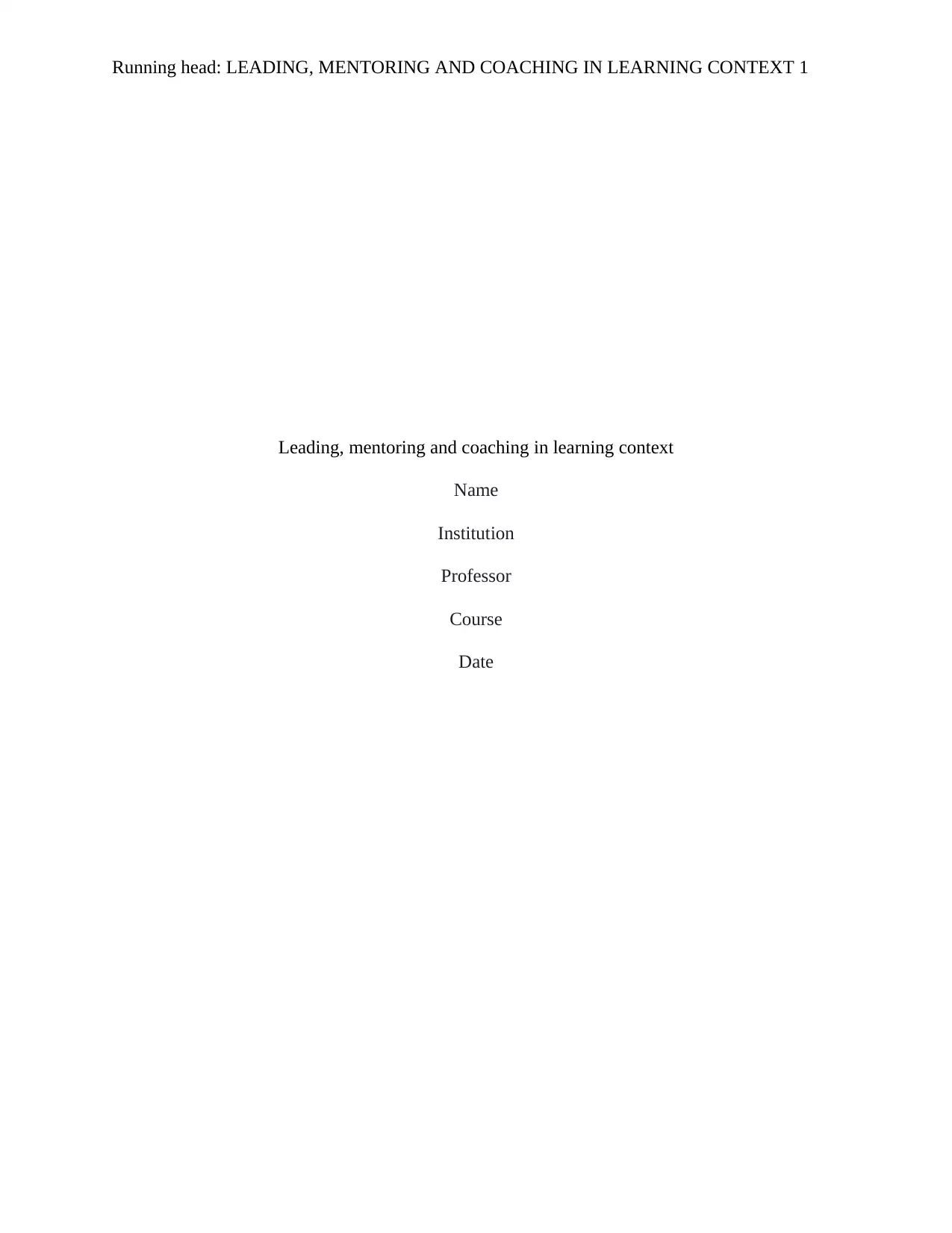
Running head: LEADING, MENTORING AND COACHING IN LEARNING CONTEXT 1
Leading, mentoring and coaching in learning context
Name
Institution
Professor
Course
Date
Leading, mentoring and coaching in learning context
Name
Institution
Professor
Course
Date
Secure Best Marks with AI Grader
Need help grading? Try our AI Grader for instant feedback on your assignments.
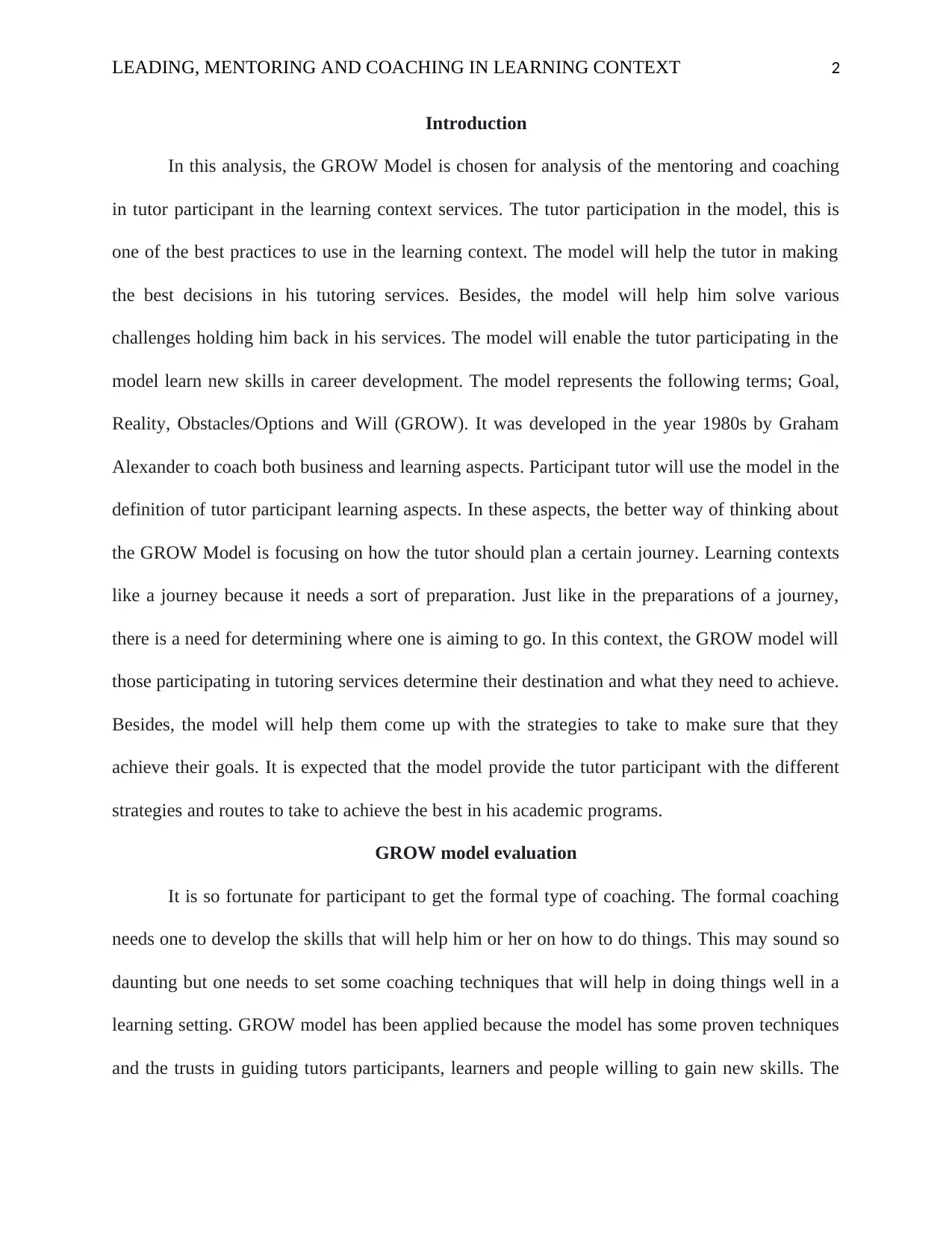
LEADING, MENTORING AND COACHING IN LEARNING CONTEXT 2
Introduction
In this analysis, the GROW Model is chosen for analysis of the mentoring and coaching
in tutor participant in the learning context services. The tutor participation in the model, this is
one of the best practices to use in the learning context. The model will help the tutor in making
the best decisions in his tutoring services. Besides, the model will help him solve various
challenges holding him back in his services. The model will enable the tutor participating in the
model learn new skills in career development. The model represents the following terms; Goal,
Reality, Obstacles/Options and Will (GROW). It was developed in the year 1980s by Graham
Alexander to coach both business and learning aspects. Participant tutor will use the model in the
definition of tutor participant learning aspects. In these aspects, the better way of thinking about
the GROW Model is focusing on how the tutor should plan a certain journey. Learning contexts
like a journey because it needs a sort of preparation. Just like in the preparations of a journey,
there is a need for determining where one is aiming to go. In this context, the GROW model will
those participating in tutoring services determine their destination and what they need to achieve.
Besides, the model will help them come up with the strategies to take to make sure that they
achieve their goals. It is expected that the model provide the tutor participant with the different
strategies and routes to take to achieve the best in his academic programs.
GROW model evaluation
It is so fortunate for participant to get the formal type of coaching. The formal coaching
needs one to develop the skills that will help him or her on how to do things. This may sound so
daunting but one needs to set some coaching techniques that will help in doing things well in a
learning setting. GROW model has been applied because the model has some proven techniques
and the trusts in guiding tutors participants, learners and people willing to gain new skills. The
Introduction
In this analysis, the GROW Model is chosen for analysis of the mentoring and coaching
in tutor participant in the learning context services. The tutor participation in the model, this is
one of the best practices to use in the learning context. The model will help the tutor in making
the best decisions in his tutoring services. Besides, the model will help him solve various
challenges holding him back in his services. The model will enable the tutor participating in the
model learn new skills in career development. The model represents the following terms; Goal,
Reality, Obstacles/Options and Will (GROW). It was developed in the year 1980s by Graham
Alexander to coach both business and learning aspects. Participant tutor will use the model in the
definition of tutor participant learning aspects. In these aspects, the better way of thinking about
the GROW Model is focusing on how the tutor should plan a certain journey. Learning contexts
like a journey because it needs a sort of preparation. Just like in the preparations of a journey,
there is a need for determining where one is aiming to go. In this context, the GROW model will
those participating in tutoring services determine their destination and what they need to achieve.
Besides, the model will help them come up with the strategies to take to make sure that they
achieve their goals. It is expected that the model provide the tutor participant with the different
strategies and routes to take to achieve the best in his academic programs.
GROW model evaluation
It is so fortunate for participant to get the formal type of coaching. The formal coaching
needs one to develop the skills that will help him or her on how to do things. This may sound so
daunting but one needs to set some coaching techniques that will help in doing things well in a
learning setting. GROW model has been applied because the model has some proven techniques
and the trusts in guiding tutors participants, learners and people willing to gain new skills. The
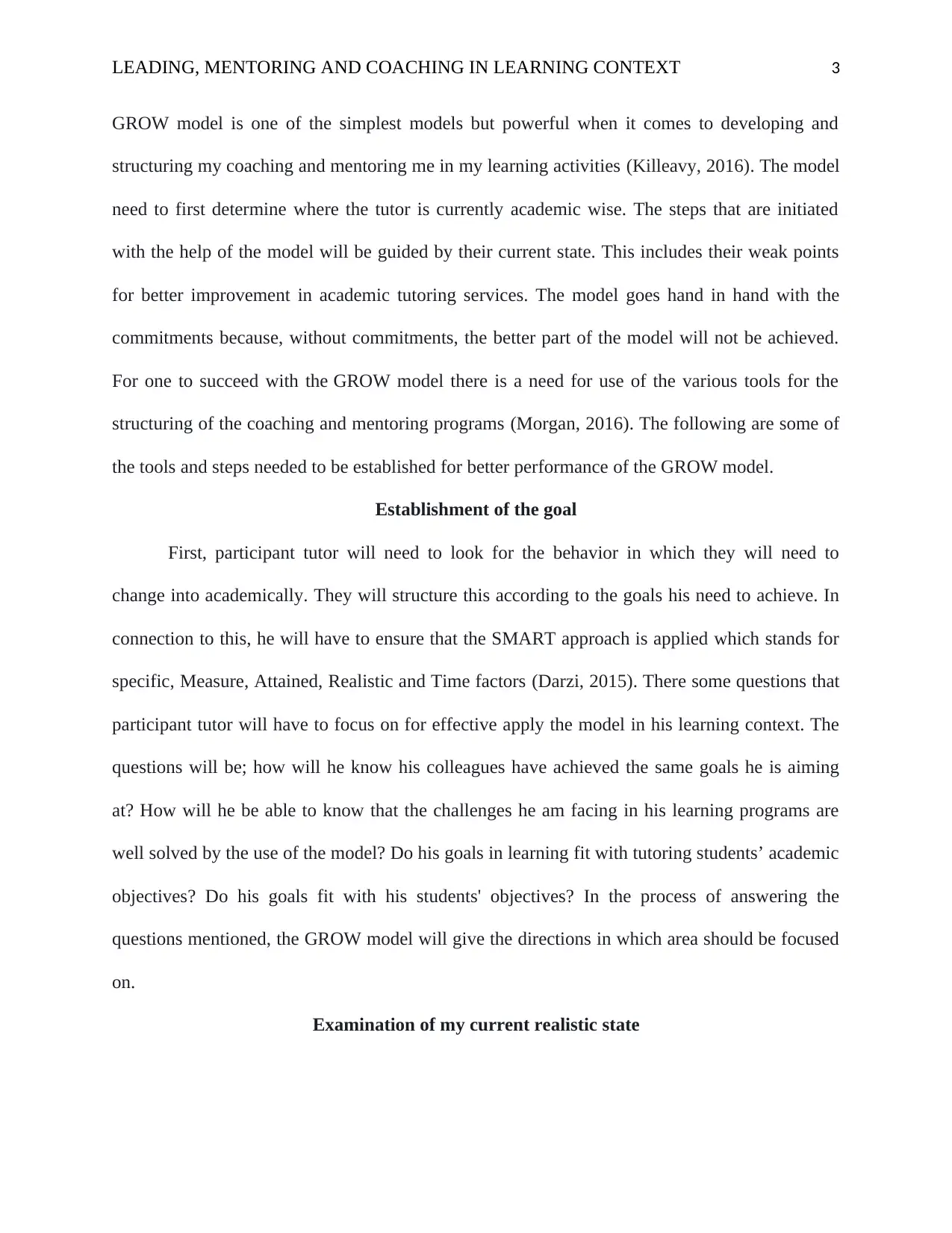
LEADING, MENTORING AND COACHING IN LEARNING CONTEXT 3
GROW model is one of the simplest models but powerful when it comes to developing and
structuring my coaching and mentoring me in my learning activities (Killeavy, 2016). The model
need to first determine where the tutor is currently academic wise. The steps that are initiated
with the help of the model will be guided by their current state. This includes their weak points
for better improvement in academic tutoring services. The model goes hand in hand with the
commitments because, without commitments, the better part of the model will not be achieved.
For one to succeed with the GROW model there is a need for use of the various tools for the
structuring of the coaching and mentoring programs (Morgan, 2016). The following are some of
the tools and steps needed to be established for better performance of the GROW model.
Establishment of the goal
First, participant tutor will need to look for the behavior in which they will need to
change into academically. They will structure this according to the goals his need to achieve. In
connection to this, he will have to ensure that the SMART approach is applied which stands for
specific, Measure, Attained, Realistic and Time factors (Darzi, 2015). There some questions that
participant tutor will have to focus on for effective apply the model in his learning context. The
questions will be; how will he know his colleagues have achieved the same goals he is aiming
at? How will he be able to know that the challenges he am facing in his learning programs are
well solved by the use of the model? Do his goals in learning fit with tutoring students’ academic
objectives? Do his goals fit with his students' objectives? In the process of answering the
questions mentioned, the GROW model will give the directions in which area should be focused
on.
Examination of my current realistic state
GROW model is one of the simplest models but powerful when it comes to developing and
structuring my coaching and mentoring me in my learning activities (Killeavy, 2016). The model
need to first determine where the tutor is currently academic wise. The steps that are initiated
with the help of the model will be guided by their current state. This includes their weak points
for better improvement in academic tutoring services. The model goes hand in hand with the
commitments because, without commitments, the better part of the model will not be achieved.
For one to succeed with the GROW model there is a need for use of the various tools for the
structuring of the coaching and mentoring programs (Morgan, 2016). The following are some of
the tools and steps needed to be established for better performance of the GROW model.
Establishment of the goal
First, participant tutor will need to look for the behavior in which they will need to
change into academically. They will structure this according to the goals his need to achieve. In
connection to this, he will have to ensure that the SMART approach is applied which stands for
specific, Measure, Attained, Realistic and Time factors (Darzi, 2015). There some questions that
participant tutor will have to focus on for effective apply the model in his learning context. The
questions will be; how will he know his colleagues have achieved the same goals he is aiming
at? How will he be able to know that the challenges he am facing in his learning programs are
well solved by the use of the model? Do his goals in learning fit with tutoring students’ academic
objectives? Do his goals fit with his students' objectives? In the process of answering the
questions mentioned, the GROW model will give the directions in which area should be focused
on.
Examination of my current realistic state
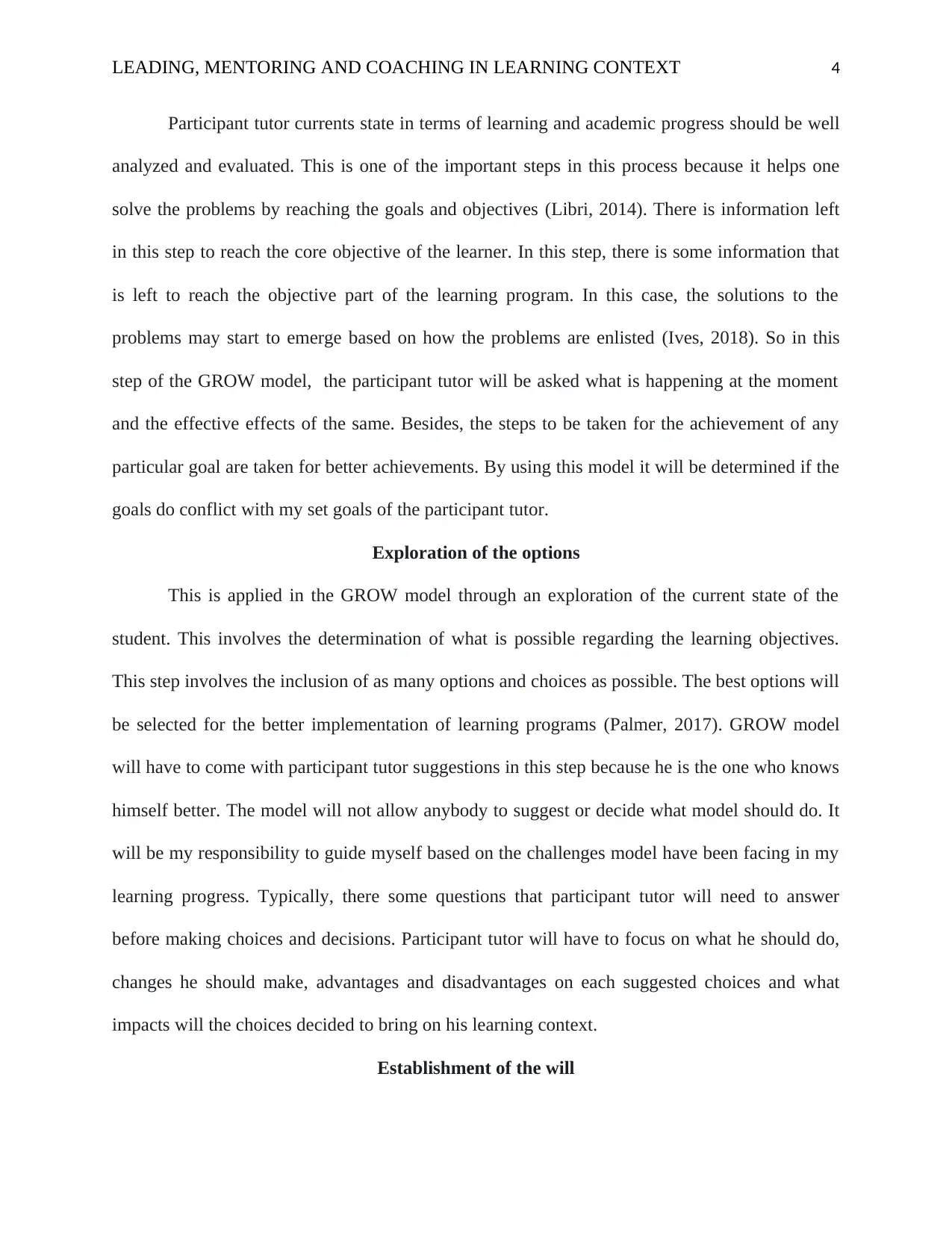
LEADING, MENTORING AND COACHING IN LEARNING CONTEXT 4
Participant tutor currents state in terms of learning and academic progress should be well
analyzed and evaluated. This is one of the important steps in this process because it helps one
solve the problems by reaching the goals and objectives (Libri, 2014). There is information left
in this step to reach the core objective of the learner. In this step, there is some information that
is left to reach the objective part of the learning program. In this case, the solutions to the
problems may start to emerge based on how the problems are enlisted (Ives, 2018). So in this
step of the GROW model, the participant tutor will be asked what is happening at the moment
and the effective effects of the same. Besides, the steps to be taken for the achievement of any
particular goal are taken for better achievements. By using this model it will be determined if the
goals do conflict with my set goals of the participant tutor.
Exploration of the options
This is applied in the GROW model through an exploration of the current state of the
student. This involves the determination of what is possible regarding the learning objectives.
This step involves the inclusion of as many options and choices as possible. The best options will
be selected for the better implementation of learning programs (Palmer, 2017). GROW model
will have to come with participant tutor suggestions in this step because he is the one who knows
himself better. The model will not allow anybody to suggest or decide what model should do. It
will be my responsibility to guide myself based on the challenges model have been facing in my
learning progress. Typically, there some questions that participant tutor will need to answer
before making choices and decisions. Participant tutor will have to focus on what he should do,
changes he should make, advantages and disadvantages on each suggested choices and what
impacts will the choices decided to bring on his learning context.
Establishment of the will
Participant tutor currents state in terms of learning and academic progress should be well
analyzed and evaluated. This is one of the important steps in this process because it helps one
solve the problems by reaching the goals and objectives (Libri, 2014). There is information left
in this step to reach the core objective of the learner. In this step, there is some information that
is left to reach the objective part of the learning program. In this case, the solutions to the
problems may start to emerge based on how the problems are enlisted (Ives, 2018). So in this
step of the GROW model, the participant tutor will be asked what is happening at the moment
and the effective effects of the same. Besides, the steps to be taken for the achievement of any
particular goal are taken for better achievements. By using this model it will be determined if the
goals do conflict with my set goals of the participant tutor.
Exploration of the options
This is applied in the GROW model through an exploration of the current state of the
student. This involves the determination of what is possible regarding the learning objectives.
This step involves the inclusion of as many options and choices as possible. The best options will
be selected for the better implementation of learning programs (Palmer, 2017). GROW model
will have to come with participant tutor suggestions in this step because he is the one who knows
himself better. The model will not allow anybody to suggest or decide what model should do. It
will be my responsibility to guide myself based on the challenges model have been facing in my
learning progress. Typically, there some questions that participant tutor will need to answer
before making choices and decisions. Participant tutor will have to focus on what he should do,
changes he should make, advantages and disadvantages on each suggested choices and what
impacts will the choices decided to bring on his learning context.
Establishment of the will
Secure Best Marks with AI Grader
Need help grading? Try our AI Grader for instant feedback on your assignments.
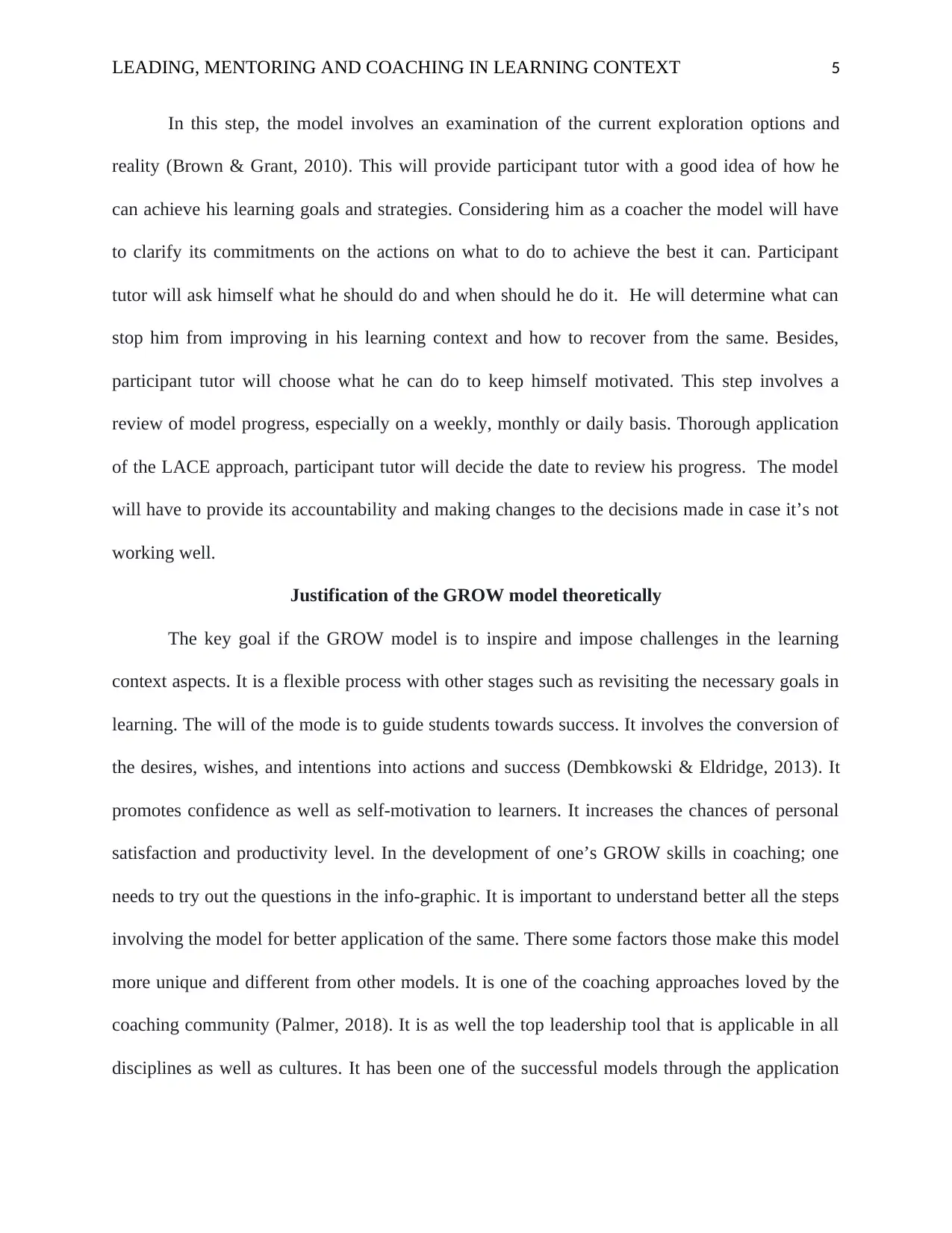
LEADING, MENTORING AND COACHING IN LEARNING CONTEXT 5
In this step, the model involves an examination of the current exploration options and
reality (Brown & Grant, 2010). This will provide participant tutor with a good idea of how he
can achieve his learning goals and strategies. Considering him as a coacher the model will have
to clarify its commitments on the actions on what to do to achieve the best it can. Participant
tutor will ask himself what he should do and when should he do it. He will determine what can
stop him from improving in his learning context and how to recover from the same. Besides,
participant tutor will choose what he can do to keep himself motivated. This step involves a
review of model progress, especially on a weekly, monthly or daily basis. Thorough application
of the LACE approach, participant tutor will decide the date to review his progress. The model
will have to provide its accountability and making changes to the decisions made in case it’s not
working well.
Justification of the GROW model theoretically
The key goal if the GROW model is to inspire and impose challenges in the learning
context aspects. It is a flexible process with other stages such as revisiting the necessary goals in
learning. The will of the mode is to guide students towards success. It involves the conversion of
the desires, wishes, and intentions into actions and success (Dembkowski & Eldridge, 2013). It
promotes confidence as well as self-motivation to learners. It increases the chances of personal
satisfaction and productivity level. In the development of one’s GROW skills in coaching; one
needs to try out the questions in the info-graphic. It is important to understand better all the steps
involving the model for better application of the same. There some factors those make this model
more unique and different from other models. It is one of the coaching approaches loved by the
coaching community (Palmer, 2018). It is as well the top leadership tool that is applicable in all
disciplines as well as cultures. It has been one of the successful models through the application
In this step, the model involves an examination of the current exploration options and
reality (Brown & Grant, 2010). This will provide participant tutor with a good idea of how he
can achieve his learning goals and strategies. Considering him as a coacher the model will have
to clarify its commitments on the actions on what to do to achieve the best it can. Participant
tutor will ask himself what he should do and when should he do it. He will determine what can
stop him from improving in his learning context and how to recover from the same. Besides,
participant tutor will choose what he can do to keep himself motivated. This step involves a
review of model progress, especially on a weekly, monthly or daily basis. Thorough application
of the LACE approach, participant tutor will decide the date to review his progress. The model
will have to provide its accountability and making changes to the decisions made in case it’s not
working well.
Justification of the GROW model theoretically
The key goal if the GROW model is to inspire and impose challenges in the learning
context aspects. It is a flexible process with other stages such as revisiting the necessary goals in
learning. The will of the mode is to guide students towards success. It involves the conversion of
the desires, wishes, and intentions into actions and success (Dembkowski & Eldridge, 2013). It
promotes confidence as well as self-motivation to learners. It increases the chances of personal
satisfaction and productivity level. In the development of one’s GROW skills in coaching; one
needs to try out the questions in the info-graphic. It is important to understand better all the steps
involving the model for better application of the same. There some factors those make this model
more unique and different from other models. It is one of the coaching approaches loved by the
coaching community (Palmer, 2018). It is as well the top leadership tool that is applicable in all
disciplines as well as cultures. It has been one of the successful models through the application
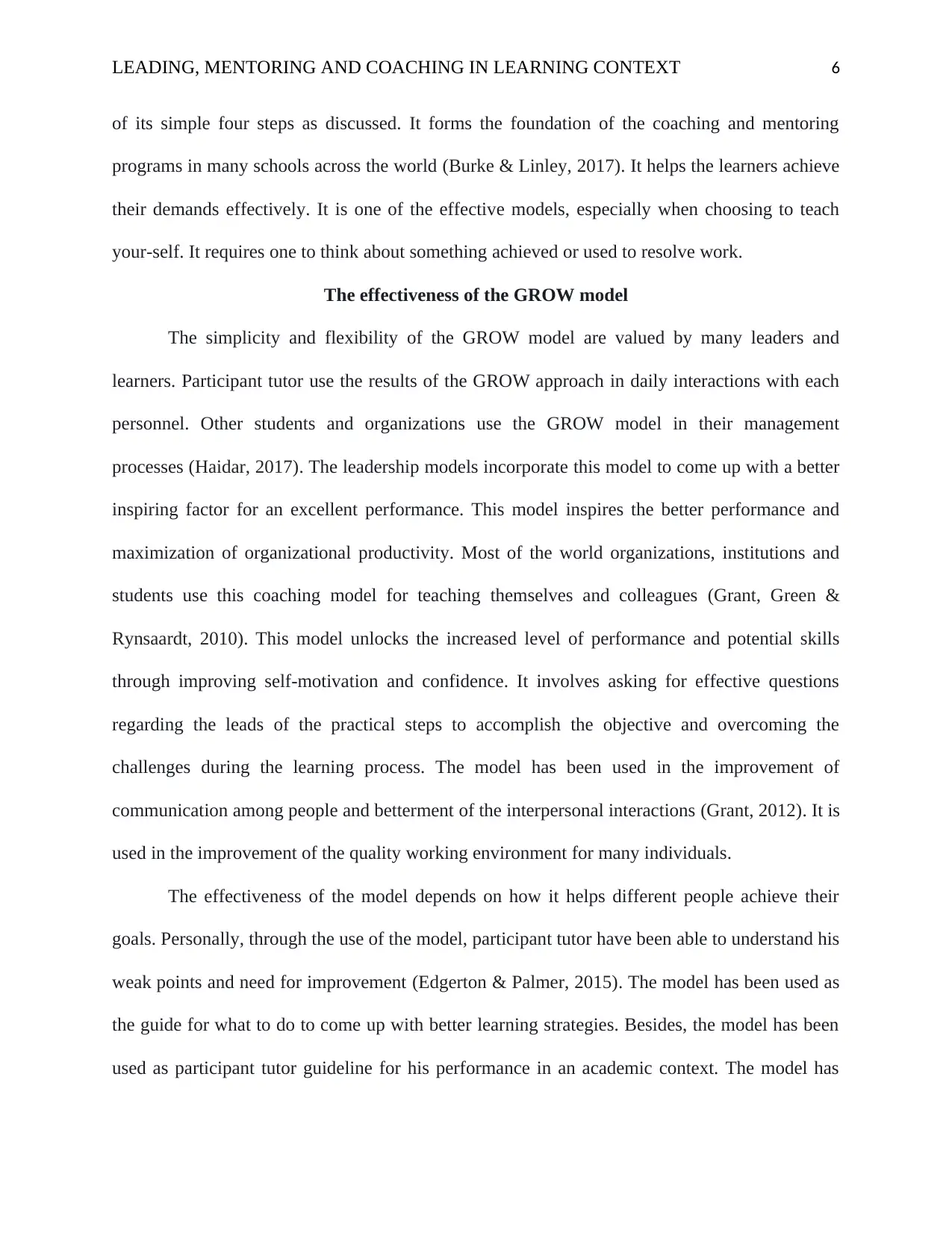
LEADING, MENTORING AND COACHING IN LEARNING CONTEXT 6
of its simple four steps as discussed. It forms the foundation of the coaching and mentoring
programs in many schools across the world (Burke & Linley, 2017). It helps the learners achieve
their demands effectively. It is one of the effective models, especially when choosing to teach
your-self. It requires one to think about something achieved or used to resolve work.
The effectiveness of the GROW model
The simplicity and flexibility of the GROW model are valued by many leaders and
learners. Participant tutor use the results of the GROW approach in daily interactions with each
personnel. Other students and organizations use the GROW model in their management
processes (Haidar, 2017). The leadership models incorporate this model to come up with a better
inspiring factor for an excellent performance. This model inspires the better performance and
maximization of organizational productivity. Most of the world organizations, institutions and
students use this coaching model for teaching themselves and colleagues (Grant, Green &
Rynsaardt, 2010). This model unlocks the increased level of performance and potential skills
through improving self-motivation and confidence. It involves asking for effective questions
regarding the leads of the practical steps to accomplish the objective and overcoming the
challenges during the learning process. The model has been used in the improvement of
communication among people and betterment of the interpersonal interactions (Grant, 2012). It is
used in the improvement of the quality working environment for many individuals.
The effectiveness of the model depends on how it helps different people achieve their
goals. Personally, through the use of the model, participant tutor have been able to understand his
weak points and need for improvement (Edgerton & Palmer, 2015). The model has been used as
the guide for what to do to come up with better learning strategies. Besides, the model has been
used as participant tutor guideline for his performance in an academic context. The model has
of its simple four steps as discussed. It forms the foundation of the coaching and mentoring
programs in many schools across the world (Burke & Linley, 2017). It helps the learners achieve
their demands effectively. It is one of the effective models, especially when choosing to teach
your-self. It requires one to think about something achieved or used to resolve work.
The effectiveness of the GROW model
The simplicity and flexibility of the GROW model are valued by many leaders and
learners. Participant tutor use the results of the GROW approach in daily interactions with each
personnel. Other students and organizations use the GROW model in their management
processes (Haidar, 2017). The leadership models incorporate this model to come up with a better
inspiring factor for an excellent performance. This model inspires the better performance and
maximization of organizational productivity. Most of the world organizations, institutions and
students use this coaching model for teaching themselves and colleagues (Grant, Green &
Rynsaardt, 2010). This model unlocks the increased level of performance and potential skills
through improving self-motivation and confidence. It involves asking for effective questions
regarding the leads of the practical steps to accomplish the objective and overcoming the
challenges during the learning process. The model has been used in the improvement of
communication among people and betterment of the interpersonal interactions (Grant, 2012). It is
used in the improvement of the quality working environment for many individuals.
The effectiveness of the model depends on how it helps different people achieve their
goals. Personally, through the use of the model, participant tutor have been able to understand his
weak points and need for improvement (Edgerton & Palmer, 2015). The model has been used as
the guide for what to do to come up with better learning strategies. Besides, the model has been
used as participant tutor guideline for his performance in an academic context. The model has

LEADING, MENTORING AND COACHING IN LEARNING CONTEXT 7
been able to use the steps applied in the model to rectify some of the issues in my studies. The
model is very easy to follow because online four simple steps are involved. GROW does not deal
with coaching itself as Sir John warns that it can be even be used by the dictators. The strength of
the models is well felt once combined with other coaching approaches and skills (Grant, 2011).
As said before, it involves unlocking the potential of the people for the maximization of their
level of performance. It focuses on raising awareness and alert regarding the responsibility of the
individual learners in a school context. The model helps in learning other than just teaching
(Lambert, 2013). It is an elegant process of structuring better effective coaching conversations.
Having seen the key features of the model, it is a much-loved coaching program by many
learners and schools.
Recommendations for improvement
There some recommendations for improvement of the model despite being one of the
best models used. As discussed earlier, the model needs back up from other models and skills for
effective functioning. This model should be incorporated with other goals orientated frameworks
for better working. There need for the establishment of the sub-models to back up the effects of
the model. LACE approach should be applied in this model to listen, acknowledge the better
approach to be used in carrying out some basic processes in the learning context. There some
things that need to be done in the improvement of the GROW model in a learning context. When
the choices are selected from the agreed moments, it is so important for the mentee to plan for
the actions in completing all the necessary activities. The model needs to have a cover of what,
who and what people do. If this is not put into consideration, it can be possible that one may
think that the mentee has left the important parts of the model intentionally which might not be
the case.
been able to use the steps applied in the model to rectify some of the issues in my studies. The
model is very easy to follow because online four simple steps are involved. GROW does not deal
with coaching itself as Sir John warns that it can be even be used by the dictators. The strength of
the models is well felt once combined with other coaching approaches and skills (Grant, 2011).
As said before, it involves unlocking the potential of the people for the maximization of their
level of performance. It focuses on raising awareness and alert regarding the responsibility of the
individual learners in a school context. The model helps in learning other than just teaching
(Lambert, 2013). It is an elegant process of structuring better effective coaching conversations.
Having seen the key features of the model, it is a much-loved coaching program by many
learners and schools.
Recommendations for improvement
There some recommendations for improvement of the model despite being one of the
best models used. As discussed earlier, the model needs back up from other models and skills for
effective functioning. This model should be incorporated with other goals orientated frameworks
for better working. There need for the establishment of the sub-models to back up the effects of
the model. LACE approach should be applied in this model to listen, acknowledge the better
approach to be used in carrying out some basic processes in the learning context. There some
things that need to be done in the improvement of the GROW model in a learning context. When
the choices are selected from the agreed moments, it is so important for the mentee to plan for
the actions in completing all the necessary activities. The model needs to have a cover of what,
who and what people do. If this is not put into consideration, it can be possible that one may
think that the mentee has left the important parts of the model intentionally which might not be
the case.
Paraphrase This Document
Need a fresh take? Get an instant paraphrase of this document with our AI Paraphraser
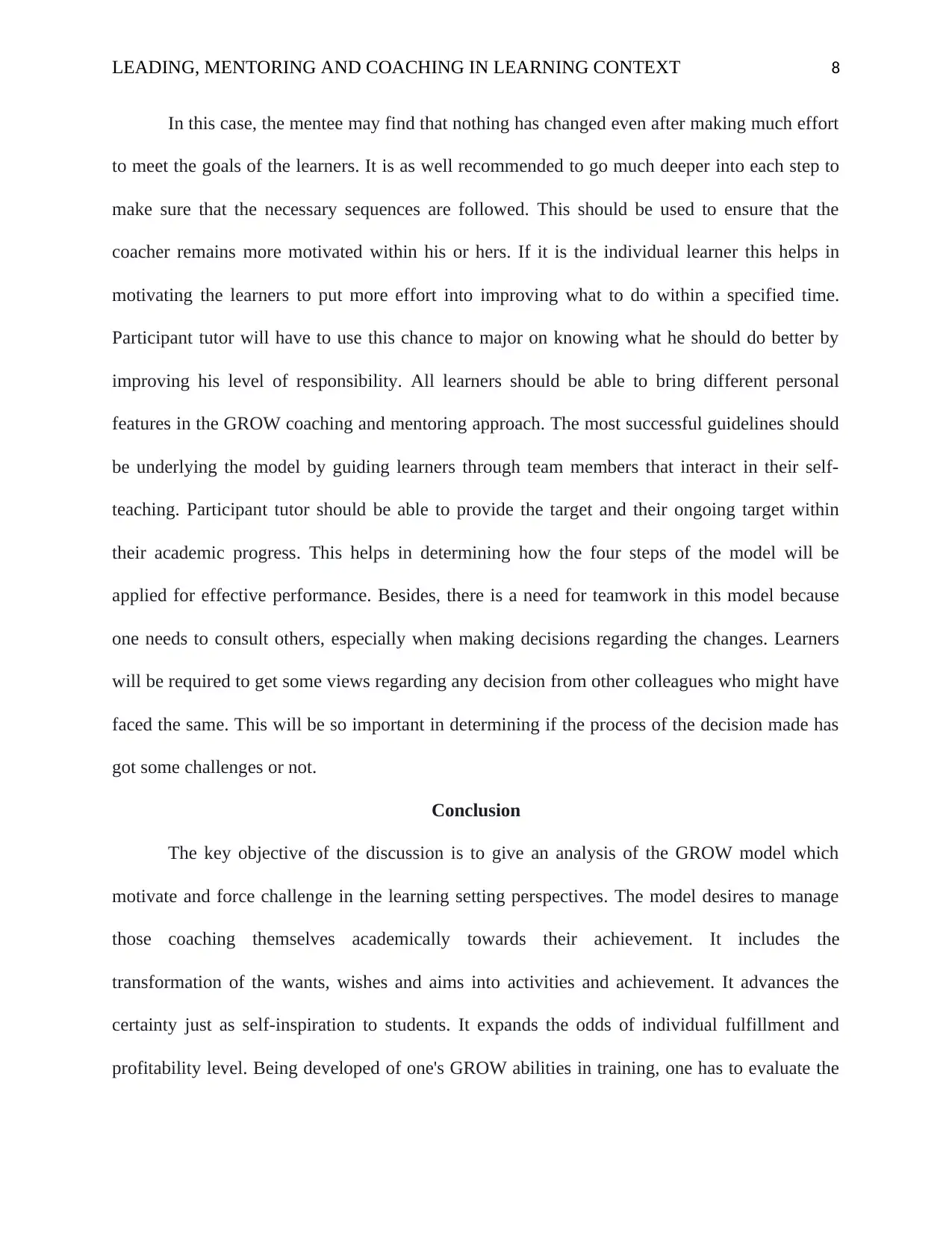
LEADING, MENTORING AND COACHING IN LEARNING CONTEXT 8
In this case, the mentee may find that nothing has changed even after making much effort
to meet the goals of the learners. It is as well recommended to go much deeper into each step to
make sure that the necessary sequences are followed. This should be used to ensure that the
coacher remains more motivated within his or hers. If it is the individual learner this helps in
motivating the learners to put more effort into improving what to do within a specified time.
Participant tutor will have to use this chance to major on knowing what he should do better by
improving his level of responsibility. All learners should be able to bring different personal
features in the GROW coaching and mentoring approach. The most successful guidelines should
be underlying the model by guiding learners through team members that interact in their self-
teaching. Participant tutor should be able to provide the target and their ongoing target within
their academic progress. This helps in determining how the four steps of the model will be
applied for effective performance. Besides, there is a need for teamwork in this model because
one needs to consult others, especially when making decisions regarding the changes. Learners
will be required to get some views regarding any decision from other colleagues who might have
faced the same. This will be so important in determining if the process of the decision made has
got some challenges or not.
Conclusion
The key objective of the discussion is to give an analysis of the GROW model which
motivate and force challenge in the learning setting perspectives. The model desires to manage
those coaching themselves academically towards their achievement. It includes the
transformation of the wants, wishes and aims into activities and achievement. It advances the
certainty just as self-inspiration to students. It expands the odds of individual fulfillment and
profitability level. Being developed of one's GROW abilities in training, one has to evaluate the
In this case, the mentee may find that nothing has changed even after making much effort
to meet the goals of the learners. It is as well recommended to go much deeper into each step to
make sure that the necessary sequences are followed. This should be used to ensure that the
coacher remains more motivated within his or hers. If it is the individual learner this helps in
motivating the learners to put more effort into improving what to do within a specified time.
Participant tutor will have to use this chance to major on knowing what he should do better by
improving his level of responsibility. All learners should be able to bring different personal
features in the GROW coaching and mentoring approach. The most successful guidelines should
be underlying the model by guiding learners through team members that interact in their self-
teaching. Participant tutor should be able to provide the target and their ongoing target within
their academic progress. This helps in determining how the four steps of the model will be
applied for effective performance. Besides, there is a need for teamwork in this model because
one needs to consult others, especially when making decisions regarding the changes. Learners
will be required to get some views regarding any decision from other colleagues who might have
faced the same. This will be so important in determining if the process of the decision made has
got some challenges or not.
Conclusion
The key objective of the discussion is to give an analysis of the GROW model which
motivate and force challenge in the learning setting perspectives. The model desires to manage
those coaching themselves academically towards their achievement. It includes the
transformation of the wants, wishes and aims into activities and achievement. It advances the
certainty just as self-inspiration to students. It expands the odds of individual fulfillment and
profitability level. Being developed of one's GROW abilities in training, one has to evaluate the
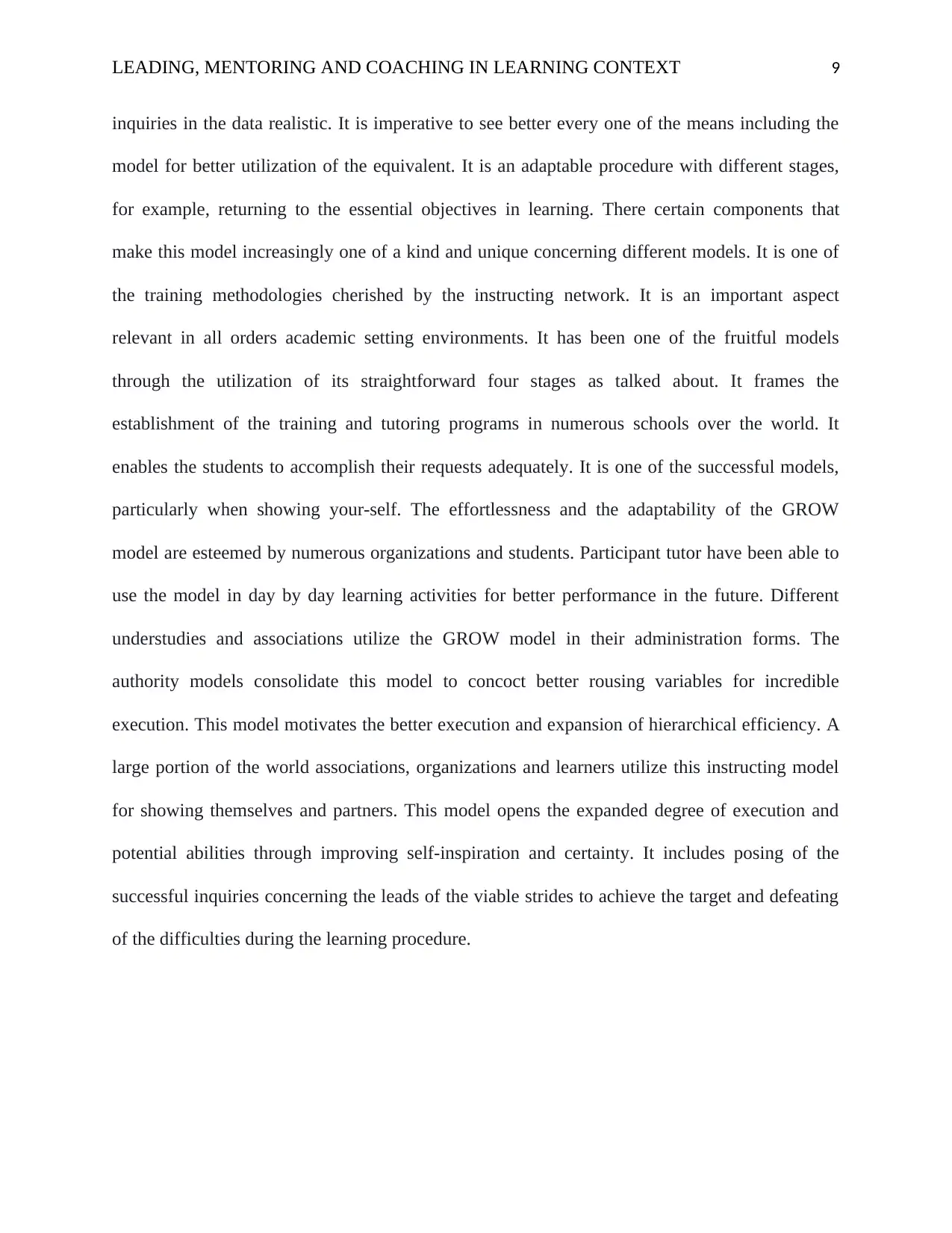
LEADING, MENTORING AND COACHING IN LEARNING CONTEXT 9
inquiries in the data realistic. It is imperative to see better every one of the means including the
model for better utilization of the equivalent. It is an adaptable procedure with different stages,
for example, returning to the essential objectives in learning. There certain components that
make this model increasingly one of a kind and unique concerning different models. It is one of
the training methodologies cherished by the instructing network. It is an important aspect
relevant in all orders academic setting environments. It has been one of the fruitful models
through the utilization of its straightforward four stages as talked about. It frames the
establishment of the training and tutoring programs in numerous schools over the world. It
enables the students to accomplish their requests adequately. It is one of the successful models,
particularly when showing your-self. The effortlessness and the adaptability of the GROW
model are esteemed by numerous organizations and students. Participant tutor have been able to
use the model in day by day learning activities for better performance in the future. Different
understudies and associations utilize the GROW model in their administration forms. The
authority models consolidate this model to concoct better rousing variables for incredible
execution. This model motivates the better execution and expansion of hierarchical efficiency. A
large portion of the world associations, organizations and learners utilize this instructing model
for showing themselves and partners. This model opens the expanded degree of execution and
potential abilities through improving self-inspiration and certainty. It includes posing of the
successful inquiries concerning the leads of the viable strides to achieve the target and defeating
of the difficulties during the learning procedure.
inquiries in the data realistic. It is imperative to see better every one of the means including the
model for better utilization of the equivalent. It is an adaptable procedure with different stages,
for example, returning to the essential objectives in learning. There certain components that
make this model increasingly one of a kind and unique concerning different models. It is one of
the training methodologies cherished by the instructing network. It is an important aspect
relevant in all orders academic setting environments. It has been one of the fruitful models
through the utilization of its straightforward four stages as talked about. It frames the
establishment of the training and tutoring programs in numerous schools over the world. It
enables the students to accomplish their requests adequately. It is one of the successful models,
particularly when showing your-self. The effortlessness and the adaptability of the GROW
model are esteemed by numerous organizations and students. Participant tutor have been able to
use the model in day by day learning activities for better performance in the future. Different
understudies and associations utilize the GROW model in their administration forms. The
authority models consolidate this model to concoct better rousing variables for incredible
execution. This model motivates the better execution and expansion of hierarchical efficiency. A
large portion of the world associations, organizations and learners utilize this instructing model
for showing themselves and partners. This model opens the expanded degree of execution and
potential abilities through improving self-inspiration and certainty. It includes posing of the
successful inquiries concerning the leads of the viable strides to achieve the target and defeating
of the difficulties during the learning procedure.
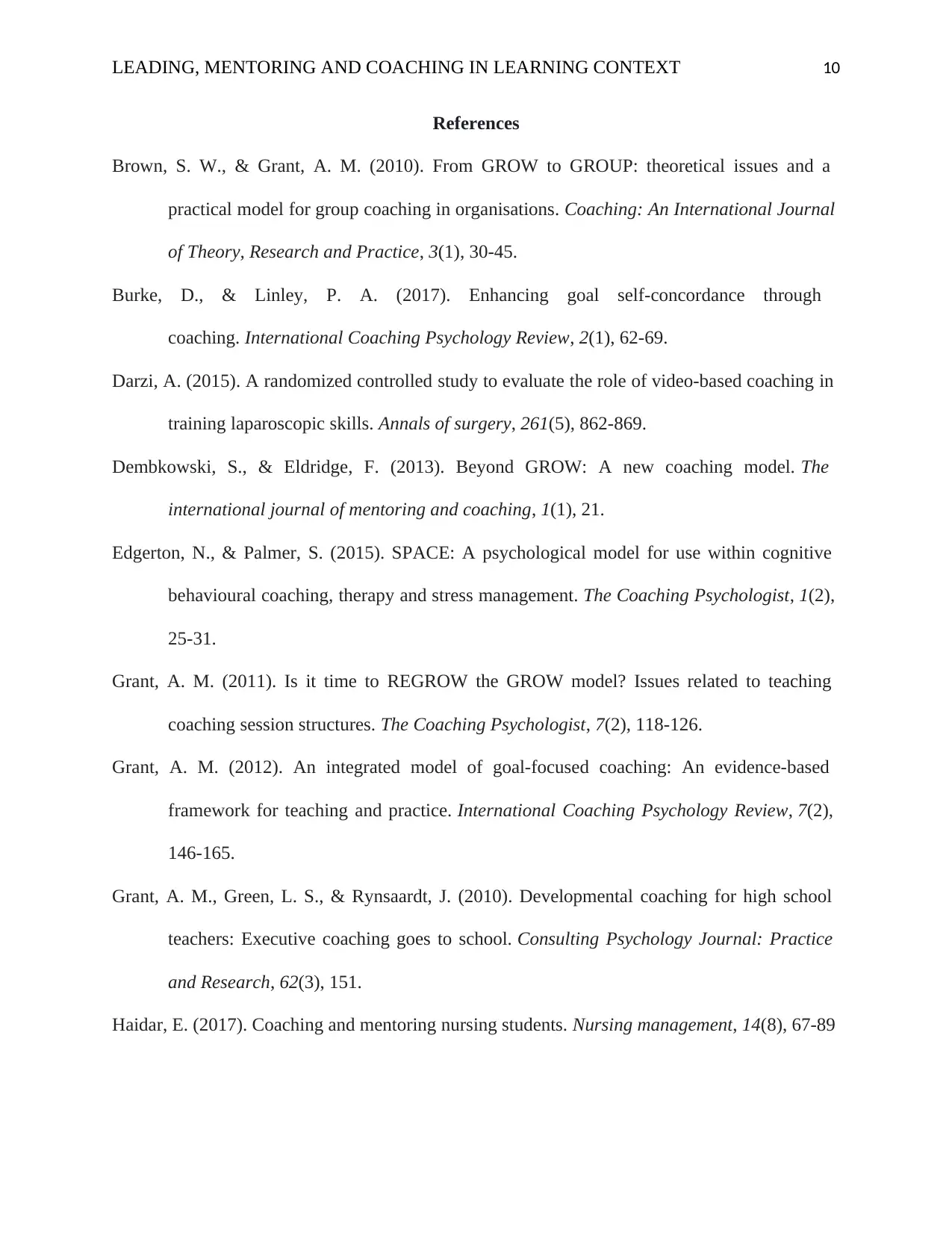
LEADING, MENTORING AND COACHING IN LEARNING CONTEXT 10
References
Brown, S. W., & Grant, A. M. (2010). From GROW to GROUP: theoretical issues and a
practical model for group coaching in organisations. Coaching: An International Journal
of Theory, Research and Practice, 3(1), 30-45.
Burke, D., & Linley, P. A. (2017). Enhancing goal self-concordance through
coaching. International Coaching Psychology Review, 2(1), 62-69.
Darzi, A. (2015). A randomized controlled study to evaluate the role of video-based coaching in
training laparoscopic skills. Annals of surgery, 261(5), 862-869.
Dembkowski, S., & Eldridge, F. (2013). Beyond GROW: A new coaching model. The
international journal of mentoring and coaching, 1(1), 21.
Edgerton, N., & Palmer, S. (2015). SPACE: A psychological model for use within cognitive
behavioural coaching, therapy and stress management. The Coaching Psychologist, 1(2),
25-31.
Grant, A. M. (2011). Is it time to REGROW the GROW model? Issues related to teaching
coaching session structures. The Coaching Psychologist, 7(2), 118-126.
Grant, A. M. (2012). An integrated model of goal-focused coaching: An evidence-based
framework for teaching and practice. International Coaching Psychology Review, 7(2),
146-165.
Grant, A. M., Green, L. S., & Rynsaardt, J. (2010). Developmental coaching for high school
teachers: Executive coaching goes to school. Consulting Psychology Journal: Practice
and Research, 62(3), 151.
Haidar, E. (2017). Coaching and mentoring nursing students. Nursing management, 14(8), 67-89
References
Brown, S. W., & Grant, A. M. (2010). From GROW to GROUP: theoretical issues and a
practical model for group coaching in organisations. Coaching: An International Journal
of Theory, Research and Practice, 3(1), 30-45.
Burke, D., & Linley, P. A. (2017). Enhancing goal self-concordance through
coaching. International Coaching Psychology Review, 2(1), 62-69.
Darzi, A. (2015). A randomized controlled study to evaluate the role of video-based coaching in
training laparoscopic skills. Annals of surgery, 261(5), 862-869.
Dembkowski, S., & Eldridge, F. (2013). Beyond GROW: A new coaching model. The
international journal of mentoring and coaching, 1(1), 21.
Edgerton, N., & Palmer, S. (2015). SPACE: A psychological model for use within cognitive
behavioural coaching, therapy and stress management. The Coaching Psychologist, 1(2),
25-31.
Grant, A. M. (2011). Is it time to REGROW the GROW model? Issues related to teaching
coaching session structures. The Coaching Psychologist, 7(2), 118-126.
Grant, A. M. (2012). An integrated model of goal-focused coaching: An evidence-based
framework for teaching and practice. International Coaching Psychology Review, 7(2),
146-165.
Grant, A. M., Green, L. S., & Rynsaardt, J. (2010). Developmental coaching for high school
teachers: Executive coaching goes to school. Consulting Psychology Journal: Practice
and Research, 62(3), 151.
Haidar, E. (2017). Coaching and mentoring nursing students. Nursing management, 14(8), 67-89
Secure Best Marks with AI Grader
Need help grading? Try our AI Grader for instant feedback on your assignments.
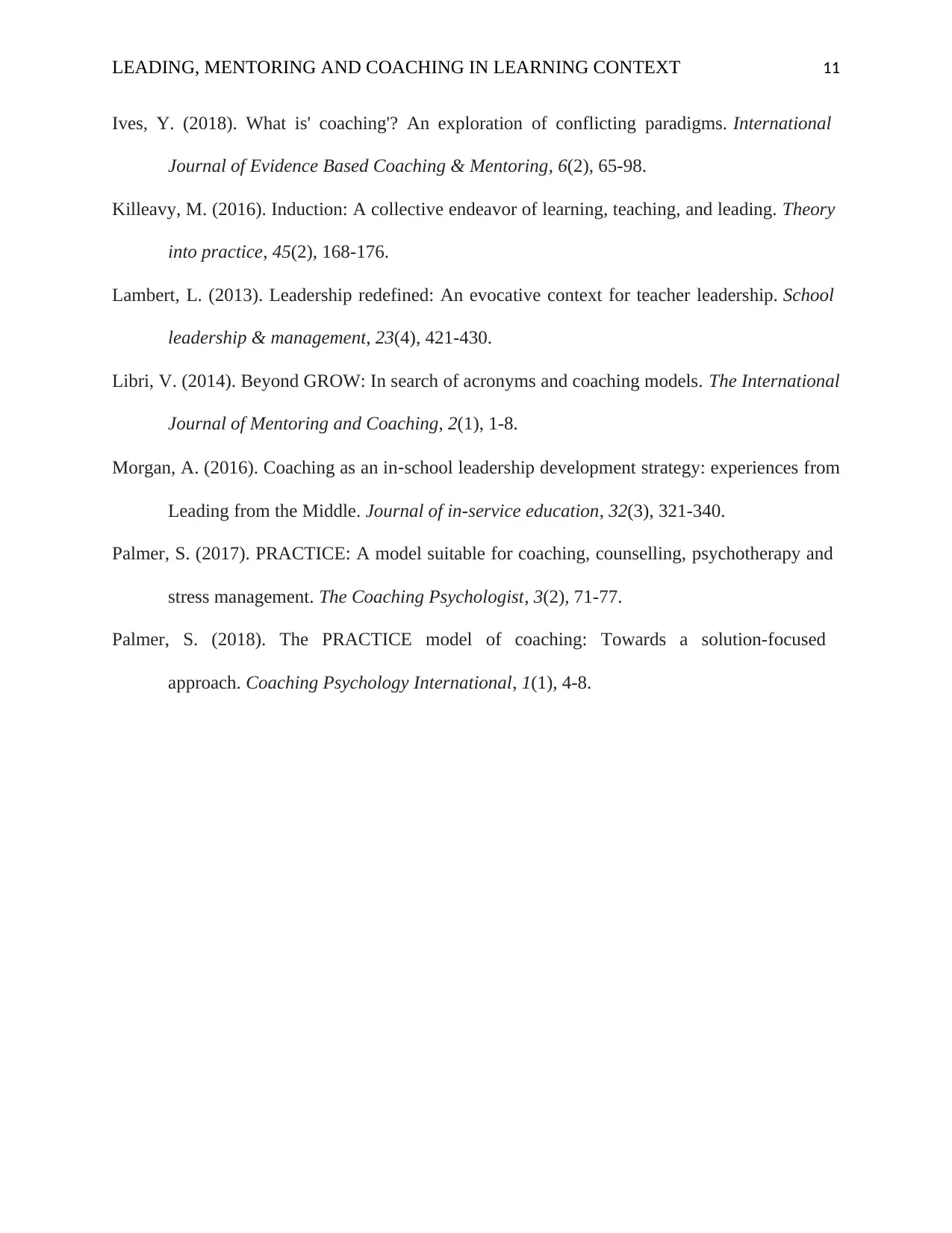
LEADING, MENTORING AND COACHING IN LEARNING CONTEXT 11
Ives, Y. (2018). What is' coaching'? An exploration of conflicting paradigms. International
Journal of Evidence Based Coaching & Mentoring, 6(2), 65-98.
Killeavy, M. (2016). Induction: A collective endeavor of learning, teaching, and leading. Theory
into practice, 45(2), 168-176.
Lambert, L. (2013). Leadership redefined: An evocative context for teacher leadership. School
leadership & management, 23(4), 421-430.
Libri, V. (2014). Beyond GROW: In search of acronyms and coaching models. The International
Journal of Mentoring and Coaching, 2(1), 1-8.
Morgan, A. (2016). Coaching as an in‐school leadership development strategy: experiences from
Leading from the Middle. Journal of in-service education, 32(3), 321-340.
Palmer, S. (2017). PRACTICE: A model suitable for coaching, counselling, psychotherapy and
stress management. The Coaching Psychologist, 3(2), 71-77.
Palmer, S. (2018). The PRACTICE model of coaching: Towards a solution-focused
approach. Coaching Psychology International, 1(1), 4-8.
Ives, Y. (2018). What is' coaching'? An exploration of conflicting paradigms. International
Journal of Evidence Based Coaching & Mentoring, 6(2), 65-98.
Killeavy, M. (2016). Induction: A collective endeavor of learning, teaching, and leading. Theory
into practice, 45(2), 168-176.
Lambert, L. (2013). Leadership redefined: An evocative context for teacher leadership. School
leadership & management, 23(4), 421-430.
Libri, V. (2014). Beyond GROW: In search of acronyms and coaching models. The International
Journal of Mentoring and Coaching, 2(1), 1-8.
Morgan, A. (2016). Coaching as an in‐school leadership development strategy: experiences from
Leading from the Middle. Journal of in-service education, 32(3), 321-340.
Palmer, S. (2017). PRACTICE: A model suitable for coaching, counselling, psychotherapy and
stress management. The Coaching Psychologist, 3(2), 71-77.
Palmer, S. (2018). The PRACTICE model of coaching: Towards a solution-focused
approach. Coaching Psychology International, 1(1), 4-8.
1 out of 11
Related Documents
Your All-in-One AI-Powered Toolkit for Academic Success.
+13062052269
info@desklib.com
Available 24*7 on WhatsApp / Email
![[object Object]](/_next/static/media/star-bottom.7253800d.svg)
Unlock your academic potential
© 2024 | Zucol Services PVT LTD | All rights reserved.




